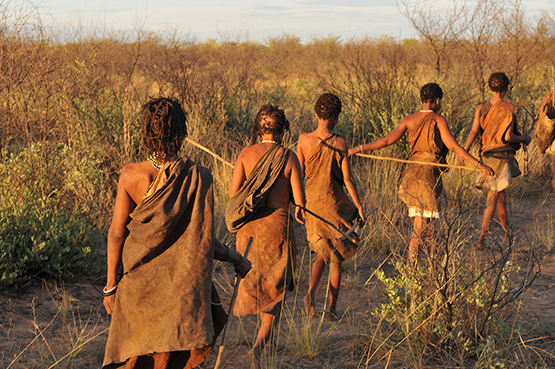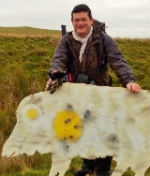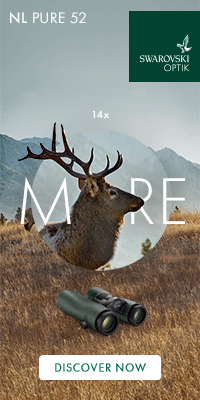Dr Simon Lee takes us on a 'whistle stop tour' looking at the diversity of hunting styles and customs around the globe.

(Above: Bushmen of the Kalahari)
This past festive season, like so many before, seemingly started just after Halloween, and for most, culminated in a feast of a so called 'traditional' yet in fact introduced species, the transatlantic turkey!
Add to this the crescendo of retail consumerism, and surely, at no other time of the year are we less connected to our environment and led yet further astray by the detachment of modern life.
Personally, as a hunter and lifelong game enthusiast, I feel more connected than most to the environment and can't imagine the Christmas spread without some healthy venison or delicious pheasant, possibly with some smoked boar ham…don’t get me started, this helps me stay connected. Indeed, throughout most of the world, hunting is clearly a means by which people remain in tune with the natural world and in some parts of the world the attachment to the natural environment is greater than in others.
So how is it done elsewhere? Let us take a look firstly at the cradle of mankind, Africa, one of the few places left on the planet where primitive life is still possible and goes on unchanged despite the technological advances of the world around it.
A rare and shrinking people, the bushmen of the Kalahari are genetically and socially unique among the peoples of Africa. Subsisting mostly on hunting and gathering as their prime focus for survival, their relationship with their environment couldn't be closer or more precarious.
Hunting for small game and birds with mostly bow and arrow and occasionally trapping, a close quarters encounter with their quarry usually consists of a lengthy stalk before a decisive arrow, enhanced by a toxin derived from a specific beetle larva, is loosed.
This stalk is conducted in complete silence by an adult with a following of helpers and apprentices through the bush and can take days at a time, the slightest spoor being meticulously followed and analysed.
The natural poison Diamphotoxin has a slow sedative effect and after some time the beast will fall, at which point the hunt is over. Beast doomed, a message/prayer of thanks to the animal for laying down it's life that others might live is given in reverent hush, with the names of those who will benefit recited in full, with detail of what part will go to whom and for what purpose.
After this acknowledgement, which can take some time depending on the size of animal and the list of recipients, the animal is gutted and skinned with very little waste, the favourite hunters perk I witnessed was the still green tripes, roasted on sticks over embers, being eagerly consumed.
Contrast this to some of the cross-pond YouTube antics of our cousins, whooping and doing victory dances after a kill, and the two approaches couldn't be further apart in sentiment and meaning. . .
Primitive hunting societies all display a higher level of connectivity with and respect to their quarry. In what remains of indigenous society in Central America, the person of the shaman or 'bruho' carries high status within the tribe.
To see the future, predict the seasons, and interpret the behaviour of the quarry, the shaman will perform ritual vision quests to the spirit world to interact with the animal gods and ancestors, aided by various psychoactive preparations, themselves composed of some borderline toxic chemicals.
Having witnessed the full fury of the strength of an ayahuasca ritual (the 'spirit of the vine'), itself no mean undertaking, producing up to 48 hours of vomiting, visions and sickness, I can confirm that it's no mild sedative. After the violent convulsions and profuse sweating phase are over, the subject is left with a serene calm and the tranquility of answers found.
In one special ceremony, the seeker is sent to find and discover their own spirit animal, which animal is found determines outlook and tribal position rather like the credence placed on a tabloid horoscope. Survivors of this more visceral ordeal describe it as 'looking through the eyes of the animal' and I doubt you could feel more connected than that.
The concept of ritual bonding with nature is a repeated theme worldwide, having been lucky enough to spend some time in Northern Lappland some years ago with the indigenous Sami people, it proved a real eye opener in how man has employed nomadic herding to his advantage. The Sami use Reindeer, otherwise known as caribou, or even Rangifer Tarandus if you're feeling scientific, almost exclusively for meat, fur and medecine, very little is wasted, a testament to thrift and recycling.
The reindeer is the staff of life to the Sami, these large, splay-hooved members of the deer family are physically well adapted to life in the Arctic circle, with thick fur, wide hooves, and a digestive system that can cope with the lean gleanings of extreme seasonal change.
Being so linked to their herds, the Saami revere their reindeer to a high degree, during winter, leaner grazing on certain lichen found on rocks produces a chemical in the deer's urine that, although harmless to deer, will produce a trance-like state when consumed by the shaman.
With a ritual deerskin drum worn on his back, the shaman or 'noaidi' will lie face down and after taking a generous draught of this liquid and accompanied by hypnotic drumming, fall into a trance that will enable him to see into the future to predict the areas of best grazing and timing to move the herds.
This ceremony also features 'yoiking', a unique type of harmonic praise song that imitates animal calls and noises. Upon harvesting a reindeer it is not uncommon for a Saami tribesman to yoik an spontaneous song of thanks to the deer, a repeated theme in cultures living so close to their environment.
I must confess I was a little sceptical, but after some initial doubts, managed to hold down about 350ml, still warm and steaming. Some minutes later, and still no wiser in my own search for the following week's lottery numbers, was left with a slight rainbow haze around all light sources, making that evening's Northern lights even more impressive.
Those expecting to visit a modern, sanitised Santa Claus up in the Arctic circle will be surprised and enlightened by the reality of Sami existence, a lifestyle possibly closer to their herds spritually than any managed livestock farming we see in the UK.
A little closer to home, Central European hunting tradition is well established, after a driven hunt in Bavaria, the downed game, mainly boar and deer (Fallow and Red) are arranged in a torchlit tableaux to be honoured after the hunt.
In the aftermath of the kill a handful of foliage is placed in the mouth of the quarry as a symbolic 'last meal', a similar sprig is put into the hunters cap, and the hunting horn blows a 'mort' to signal a kill, the curled brass horn's report yet another part of hunting etiquette unique to this part of the world.
During the tableaux more horn blowing of farewell takes place and physical forfeits and ritual humiliation of hunters for taking the wrong beast are also dished out, so be advised, shoot the right beast as directed.
Even closer to home, across the Channel, the French 'systeme communale', is reflective of a socialist heritage and has evolved into the modern day 'chasse' as it is. In my local area, what looks initially like a series of superannuated armed drunks surrounded by uncontrolled dogs in a carpark is actually the marshalling of a slick system of organised driven hunts with radios and smooth logistics.
Hunters are allocated a 'poste' and as the game is driven or moved through the woods toward them, each man covers his sector and waits in anticipation.
Any escapees from this closing net are either pursued and killed at the edges or escape to adjoining areas. Signs that 'la chasse' is approaching are the weekend baying of dogs and the presence of the ubiquitous white Berlingo van parked at corners of woodland.
Having been approved as an 'assistant de chasse', my role on these days is usually helping in the organising of logistics and moving dogs to the correct release point. Even the lowliest helper like myself, effectively the waterboy for a pack of twenty plus dogs of dubious pedigree, is entitled to a share of the kill, in my village chasse this is normally fresh wild boar sausages delivered the day after.
At the end of the day's drive the downed quarry are toasted with local brandy and a curiously familiar British style bantering takes place, after which with typical Gallic aplomb, the carcases are spirited away to the communal barn for processing, a fait accompli!
So from the primitive extremes to closer to home, having seen other cultures hunt and seen their own stalking rituals performed and their connections to their own quarry, I close by drawing attention to treatment of our quarry and our own hunting etiquette.
Usually far less social and less ritualised, and often glossed over to avoid upsetting those whose disconnected and urbanised beliefs differ from ours, deer stalking is enjoying a surprising resurgence recently.
 I personally gravitate towards a successful stalk ending in a rather typically understated British apology to the victim for the inconvenience of death, while resting assured that it's demise will keep me and my extended family healthily fed long into the future, as did both it's and our ancestors, long into the past.
I personally gravitate towards a successful stalk ending in a rather typically understated British apology to the victim for the inconvenience of death, while resting assured that it's demise will keep me and my extended family healthily fed long into the future, as did both it's and our ancestors, long into the past.
Left: Dr Simon Lee is a regular contributor to 'County Deer Stalking - Online Magazine' To read more from Simon follow this link: taming-the-variables



















